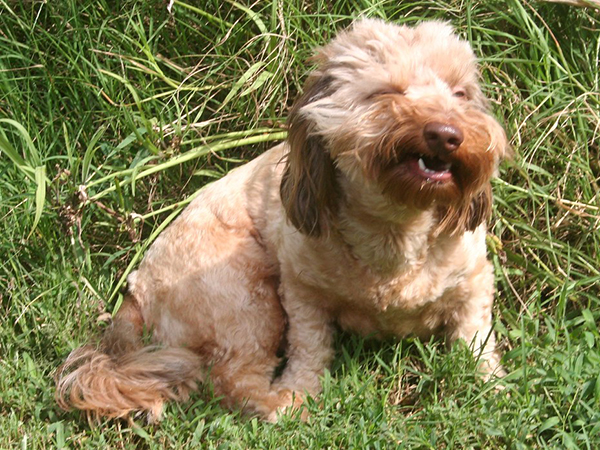What Causes Reverse Sneezing in Dogs: Understanding this Common Canine Phenomenon
|
Sep 17, 2025 - By the dedicated team of editors and writers at Newsletter Station.

|
If you're a dog owner, you may have witnessed your furry friend suddenly inhaling rapidly and making a strange, honking, or snorting noise that can be alarming. This peculiar behavior is known as "reverse sneezing." While it can be unsettling, reverse sneezing in dogs is generally harmless and typically resolves on its own.
This blog will explore what causes reverse sneezing in dogs and how you can help your canine companion when they experience this phenomenon.
What Is Reverse Sneezing?
Reverse sneezing, also known as inspiratory paroxysmal respiration or pharyngeal gag reflex, is a common but puzzling occurrence in dogs. During a reverse sneeze, a dog suddenly takes quick, shallow, and repeated inhalations through its nose. These inhalations create a distinctive snorting or honking sound, and the dog may extend its neck and appear distressed. Despite the alarming appearance, reverse sneezing is usually benign and self-limiting.
Causes of Reverse Sneezing
- Irritants and Allergens:
Dust, pollen, perfumes, cleaning products, or strong environmental odors can trigger reverse sneezing in sensitive dogs.
Allergies to airborne particles or irritants can lead to reverse sneezing, especially in breeds prone to allergies, like the Shih Tzu, Bichon Frise, or Pug.
- Overexcitement or Stress:
Dogs, tiny breeds or brachycephalic dogs with short noses, are more prone to reverse sneezing when overly excited, anxious, or stressed.
Excitement can cause dogs to inhale rapidly, leading to reverse sneezing episodes.
- Eating or Drinking:
Some dogs may experience reverse sneezing after eating or drinking too quickly. This can happen because the dog's throat is irritated or a small amount of food or liquid is ingested incorrectly.
- Foreign Objects:
Occasionally, a foreign object like a blade of grass or a small piece of debris can irritate the back of the dog's throat, triggering reverse sneezing.
- Nasal Congestion:
Nasal congestion due to infections, colds, or other respiratory issues can cause reverse sneezing as the dog tries to clear their airways.
- Breed Predisposition:
Certain breeds, such as brachycephalic breeds (e.g., Bulldogs, Pugs, Boston Terriers) and small toy breeds (e.g., Chihuahuas, Toy Poodles), are more prone to reverse sneezing due to their unique anatomy and sensitivity.
How to Help Your Dog During a Reverse Sneezing Episode
- Remain Calm:
It's essential to stay calm when your dog experiences a reverse sneezing episode. Most episodes are harmless and brief.
- Gently Massage the Throat:
If your dog is comfortable with it, gently massage their throat to help alleviate irritation and encourage normal breathing.
- Block the Nostrils:
Covering your dog's nostrils briefly with your hand can stimulate swallowing and stop the reverse sneezing episode.
- Offer a Treat or Water:
Giving your dog a treat or offering a small amount of water can help distract them and interrupt the episode.
- Avoid Overexcitement:
Identify and minimize triggers that lead to reverse sneezing in your dog, such as overexcitement or irritant exposure.
When to Consult a Veterinarian
While reverse sneezing is usually harmless, there are situations where you should consult your veterinarian:
- If your dog experiences frequent and prolonged reverse sneezing episodes.
- If your dog has difficulty breathing or exhibits other concerning symptoms alongside reverse sneezing.
- If your dog's reverse sneezing becomes more severe or changes in frequency or intensity.
- If you suspect an underlying health issue, such as allergies, respiratory infections, or nasal congestion.
Reverse sneezing in dogs may look distressing, but it's usually harmless and self-limiting. Understanding the potential causes of reverse sneezing can help you identify triggers and alleviate your dog's discomfort when needed.
However, if you have concerns or your dog's reverse sneezing becomes frequent or severe, don't hesitate to consult your veterinarian for guidance and reassurance about your furry friend's health. Remember, patience and care can go a long way in keeping your canine companion happy and healthy.
Unlock the Power of Email Marketing
Harness the potential of email marketing with Newsletter Station. Reach your target audience, drive conversions, and achieve your business goals.
|
More Blogs
| Sep 17, 2025 |
What Causes Reverse Sneezing in Dogs: Understanding this Common Canine Phenomenon
|
| Sep 10, 2025 |
Signs of Cancer in Dogs: What Every Pet Owner Should Know
|
| Sep 3, 2025 |
The Types of Tick Illnesses that Your Pet Can Get
|
| Aug 27, 2025 |
What Causes Pale Gums in Dogs: Understanding the Underlying Issues
|
| Aug 20, 2025 |
Common Causes of Stomach Problems in Pets
|
| Aug 13, 2025 |
The Most Common Causes of Bumps in Dogs and Cats
|
| Aug 6, 2025 |
Signs of Dehydration in a Cat or Dog: What Every Pet Owner Should Know
|
| Jul 30, 2025 |
Signs that Your Pet is Drinking Too Much
|
| Jul 23, 2025 |
What to Do If Your Pet Gets Stung
|
| Jul 16, 2025 |
How to Protect Your Dog's Paws: Tips for a Happy and Healthy Furry Friend
|
| Jul 9, 2025 |
Tips for Removing a Tick from Your Pet
|
| Jul 2, 2025 |
How to Know When It Is Too Hot to Walk Your Dog
|
|
|
|